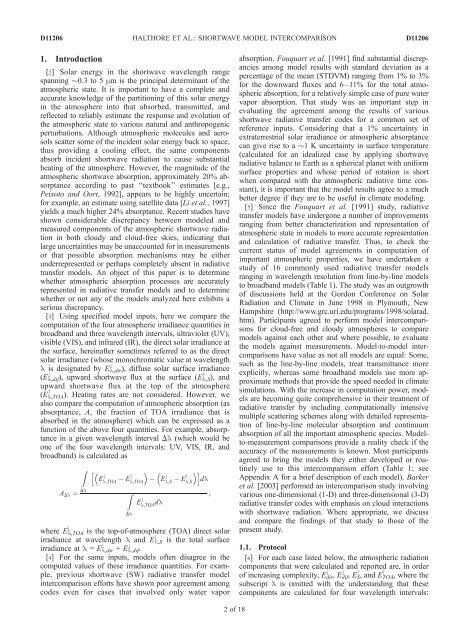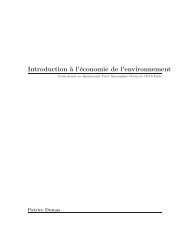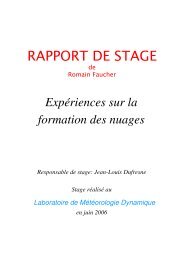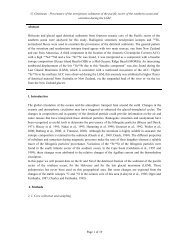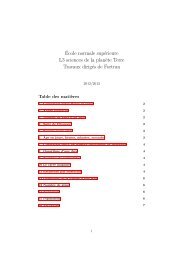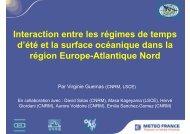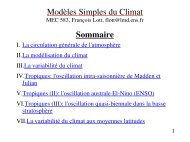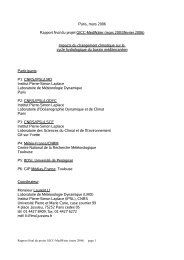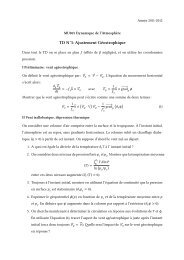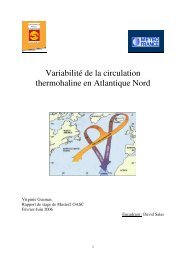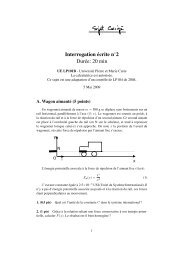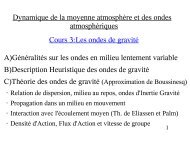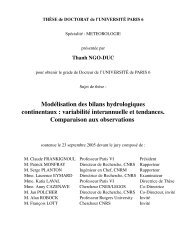Download as a PDF - CiteSeerX
Download as a PDF - CiteSeerX
Download as a PDF - CiteSeerX
Create successful ePaper yourself
Turn your PDF publications into a flip-book with our unique Google optimized e-Paper software.
D11206<br />
HALTHORE ET AL.: SHORTWAVE MODEL INTERCOMPARISON<br />
D11206<br />
1. Introduction<br />
[2] Solar energy in the shortwave wavelength range<br />
spanning 0.3 to 5 mm is the principal determinant of the<br />
atmospheric state. It is important to have a complete and<br />
accurate knowledge of the partitioning of this solar energy<br />
in the atmosphere into that absorbed, transmitted, and<br />
reflected to reliably estimate the response and evolution of<br />
the atmospheric state to various natural and anthropogenic<br />
perturbations. Although atmospheric molecules and aerosols<br />
scatter some of the incident solar energy back to space,<br />
thus providing a cooling effect, the same components<br />
absorb incident shortwave radiation to cause substantial<br />
heating of the atmosphere. However, the magnitude of the<br />
atmospheric shortwave absorption, approximately 20% absorptance<br />
according to p<strong>as</strong>t ‘‘textbook’’ estimates [e.g.,<br />
Peixoto and Oort, 1992], appears to be highly uncertain;<br />
for example, an estimate using satellite data [Li et al., 1997]<br />
yields a much higher 24% absorptance. Recent studies have<br />
shown considerable discrepancy between modeled and<br />
me<strong>as</strong>ured components of the atmospheric shortwave radiation<br />
in both cloudy and cloud-free skies, indicating that<br />
large uncertainties may be unaccounted for in me<strong>as</strong>urements<br />
or that possible absorption mechanisms may be either<br />
underrepresented or perhaps completely absent in radiative<br />
transfer models. An object of this paper is to determine<br />
whether atmospheric absorption processes are accurately<br />
represented in radiative transfer models and to determine<br />
whether or not any of the models analyzed here exhibits a<br />
serious discrepancy.<br />
[3] Using specified model inputs, here we compare the<br />
computation of the four atmospheric irradiance quantities in<br />
broadband and three wavelength intervals, ultraviolet (UV),<br />
visible (VIS), and infrared (IR), the direct solar irradiance at<br />
the surface, hereinafter sometimes referred to <strong>as</strong> the direct<br />
solar irradiance (whose monochromatic value at wavelength<br />
#<br />
l is designated by E l,dir ), diffuse solar surface irradiance<br />
#<br />
(E l,dif ), upward shortwave flux at the surface (E " l,S ), and<br />
upward shortwave flux at the top of the atmosphere<br />
"<br />
(E l,TOA<br />
). Heating rates are not considered. However, we<br />
also compare the computation of atmospheric absorption (<strong>as</strong><br />
absorptance, A, the fraction of TOA irradiance that is<br />
absorbed in the atmosphere) which can be expressed <strong>as</strong> a<br />
function of the above four quantities. For example, absorptance<br />
in a given wavelength interval Dl (which would be<br />
one of the four wavelength intervals: UV, VIS, IR, and<br />
broadband) is calculated <strong>as</strong><br />
A Dl ¼<br />
Z<br />
Dl<br />
h<br />
E # l;TOA<br />
E " l;TOA<br />
Z<br />
Dl<br />
<br />
<br />
E # l;S<br />
E " l;S<br />
i<br />
dl<br />
E # l;TOA dl ;<br />
#<br />
where E l,TOA is the top-of-atmosphere (TOA) direct solar<br />
#<br />
irradiance at wavelength l and E l,S is the total surface<br />
# #<br />
irradiance at l = E l,dir + E l,dif .<br />
[4] For the same inputs, models often disagree in the<br />
computed values of these irradiance quantities. For example,<br />
previous shortwave (SW) radiative transfer model<br />
intercomparison efforts have shown poor agreement among<br />
codes even for c<strong>as</strong>es that involved only water vapor<br />
absorption. Fouquart et al. [1991] find substantial discrepancies<br />
among model results with standard deviation <strong>as</strong> a<br />
percentage of the mean (STDVM) ranging from 1% to 3%<br />
for the downward fluxes and 6–11% for the total atmospheric<br />
absorption, for a relatively simple c<strong>as</strong>e of pure water<br />
vapor absorption. That study w<strong>as</strong> an important step in<br />
evaluating the agreement among the results of various<br />
shortwave radiative transfer codes for a common set of<br />
reference inputs. Considering that a 1% uncertainty in<br />
extraterrestrial solar irradiance or atmospheric absorptance<br />
can give rise to a 1 K uncertainty in surface temperature<br />
(calculated for an idealized c<strong>as</strong>e by applying shortwave<br />
radiative balance to Earth <strong>as</strong> a spherical planet with uniform<br />
surface properties and whose period of rotation is short<br />
when compared with the atmospheric radiative time constant),<br />
it is important that the model results agree to a much<br />
better degree if they are to be useful in climate modeling.<br />
[5] Since the Fouquart et al. [1991] study, radiative<br />
transfer models have undergone a number of improvements<br />
ranging from better characterization and representation of<br />
atmospheric state in models to more accurate representation<br />
and calculation of radiative transfer. Thus, to check the<br />
current status of model agreements in computation of<br />
important atmospheric properties, we have undertaken a<br />
study of 16 commonly used radiative transfer models<br />
ranging in wavelength resolution from line-by-line models<br />
to broadband models (Table 1). The study w<strong>as</strong> an outgrowth<br />
of discussions held at the Gordon Conference on Solar<br />
Radiation and Climate in June 1998 in Plymouth, New<br />
Hampshire (http://www.grc.uri.edu/programs/1998/solarad.<br />
htm). Participants agreed to perform model intercomparisons<br />
for cloud-free and cloudy atmospheres to compare<br />
models against each other and where possible, to evaluate<br />
the models against me<strong>as</strong>urements. Model-to-model intercomparisons<br />
have value <strong>as</strong> not all models are equal: Some,<br />
such <strong>as</strong> the line-by-line models, treat transmittance more<br />
explicitly, where<strong>as</strong> some broadband models use more approximate<br />
methods that provide the speed needed in climate<br />
simulations. With the incre<strong>as</strong>e in computation power, models<br />
are becoming quite comprehensive in their treatment of<br />
radiative transfer by including computationally intensive<br />
multiple scattering schemes along with detailed representation<br />
of line-by-line molecular absorption and continuum<br />
absorption of all the important atmospheric species. Modelto-me<strong>as</strong>urement<br />
comparisons provide a reality check if the<br />
accuracy of the me<strong>as</strong>urements is known. Most participants<br />
agreed to bring the models they either developed or routinely<br />
use to this intercomparison effort (Table 1; see<br />
Appendix A for a brief description of each model). Barker<br />
et al. [2003] performed an intercomparison study involving<br />
various one-dimensional (1-D) and three-dimensional (3-D)<br />
radiative transfer codes with emph<strong>as</strong>is on cloud interactions<br />
with shortwave radiation. Where appropriate, we discuss<br />
and compare the findings of that study to those of the<br />
present study.<br />
1.1. Protocol<br />
[6] For each c<strong>as</strong>e listed below, the atmospheric radiation<br />
components that were calculated and reported are, in order<br />
of incre<strong>as</strong>ing complexity, E # dir , E # dif , E " "<br />
S , and E TOA , where the<br />
subscript l is omitted with the understanding that these<br />
components are calculated for four wavelength intervals:<br />
2of18


